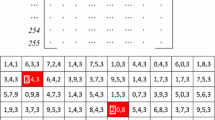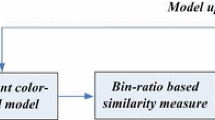Abstract
Tracking objects is an important field for many applications like driving assistance and video surveillance. Every tracking system should be able to track objects in complex scenes. One of the most challenging problems is tracking of objects undergoing an occlusion. Indeed, several tracking systems suffer from lack of information to accomplish the tracking task when two or many objects are in occlusion. To address this issue, this paper presents a novel approach combining fuzzy logic with chromatic co-occurrence matrices in order to develop a robust tracking method that is able to determine the target position more accurately during an illumination variation or an occlusion situation. The qualitative and quantitative studies on challenging sequences demonstrate that the results obtained by the proposed algorithm are very competitive in comparison with several state-of-the-art methods.








Similar content being viewed by others
References
Zhang Y, Lu H, Zhang L, Ruan X, Sakai S (2016) Video anomaly detection based on locality sensitive hashing filters. Pattern Recogn 59:302–311
Forkan ARM, Khalil I, Tari Z, Foufou S, Bouras A (2015) A context-aware approach for long-term behavioural change detection and abnormality prediction in ambient assisted living. Pattern Recogn 48(3):628–641
Wang J, Zhang L, Zhang D, Li K (2013) An adaptive longitudinal driving assistance system based on driver characteristics. IEEE Trans Intell Transp Syst 14(1):1–12
Messelodi S, Modena CM, Zanin M (2005) A computer vision system for the detection and classification of vehicles at urban road intersections. Pattern Anal Appl 8(1–2):17–31
Benavidez P, Jamshidi M (2011) Mobile robot navigation and target tracking system. In: 2011 6th international conference on system of systems engineering (SoSE), pp 299–304
Ding S, Zhai Q, Li Y, Zhu J, Zheng YF, Xuan D (2016) Simultaneous body part and motion identification for human-following robots. Pattern Recogn 50:118–130
De-la-Torre M, Granger E, Sabourin R, Gorodnichy DO (2015) Adaptive skew-sensitive ensembles for face recognition in video surveillance. Pattern Recogn 48(11):3385–3406
Wang X (2013) Intelligent multi-camera video surveillance: a review. Pattern Recogn Lett 34(1):3–19
Elafi I, Jedra M, Zahid N (2016) Unsupervised detection and tracking of moving objects for video surveillance applications. Pattern Recogn Lett 84:70–77
Zhong Z, Zhang B, Lu G, Zhao Y, Xu Y (2017) An adaptive background modeling method for foreground segmentation. IEEE Trans Intell Transp Syst 18(5):1109–1121
Jepson AD, Fleet DJ, Black MJ (2002) A layered motion representation with occlusion and compact spatial support. In :European conference in computer vision—ECCV 2002, pp 692–706, Copenhagen, Denmark
Fu Y, Erdem AT, Tekalp AM (2000) Tracking visible boundary of objects using occlusion adaptive motion snake. IEEE Trans Image Process 9(12):2051–2060
Nguyen HT, Smeulders AWM (2004) Fast occluded object tracking by a robust appearance filter. IEEE Trans Pattern Anal Mach Intell 26(8):1099–1104
Cucchiara R, Grana C, Tardini G, Vezzani R (2004) Probabilistic people tracking for occlusion handling. In: Proceedings of the 17th international conference on pattern recognition. ICPR 2004, Cambridge, England, vol 1, pp 132–135
Huang Y, Essa I (2005) Tracking multiple objects through occlusions. In: IEEE computer society conference on computer vision and pattern recognition. CVPR 2005, San Diego, vol 2, pp 1051–1058
Senior A, Hampapur A, Tian Y-L, Brown L, Pankanti S, Bolle R (2006) Appearance models for occlusion handling. Image Vis Comput 24(11):1233–1243
Jia X, Lu H, Yang MH (2012) Visual tracking via adaptive structural local sparse appearance model. In: IEEE conference on computer vision and pattern recognition (CVPR), Providence, Rhode Island, pp 1822–1829
Tang S, Andriluka M, Schiele B (2013) Detection and tracking of occluded people. Int J Comput Vis 110(1):58–69
Wu B, Nevatia R (2007) Detection and tracking of multiple, partially occluded humans by bayesian combination of edgelet based part detectors. Int J Comput Vis 75(2):247–266
Ding J, Tang Y, Tian H, Liu W, Huang Y (2015) Robust tracking with adaptive appearance learning and occlusion detection. Multimed Syst 1:1–15
Paschos G, Radev I, Prabakar N (2003) Image content-based retrieval using chromaticity moments. IEEE Trans Knowl Data Eng 15(5):1069–1072
Penatti OAB, Valle E, da Torres RA (2012) Comparative study of global color and texture descriptors for web image retrieval. J Vis Commun Image Represent 23(2):359–380
Upneja R, Singh C (2015) Fast computation of Jacobi–Fourier moments for invariant image recognition. Pattern Recogn 48(5):1836–1843
Hwang S-K, Kim W-Y (2006) A novel approach to the fast computation of Zernike moments. Pattern Recogn 39(11):2065–2076
Tahmasbi A, Saki F, Shokouhi SB (2011) Classification of benign and malignant masses based on Zernike moments. Comput Biol Med 41(8):726–735
Haralick RM, Shanmugam K, Dinstein I (1973) Textural features for image classification. IEEE Trans. Syst. Man Cybern SMC-3(6):610–621
Arvis V, Debain C, Berducat M, Benassi A (2011) Generalization of the cooccurrence matrix for colour images: application to colour texture classification. Image Anal Stereol 23(1):63–72
Cheng HD, Chen CH, Chiu HH (1997) Image segmentation using fuzzy homogeneity criterion. Inf Sci 98(1):237–262
Jawahar CV, Ray AK (1996) Fuzzy statistics of digital images. IEEE Signal Process Lett 3(8):225–227
Sen D, Pal SK (2006) Image segmentation using global and local fuzzy statistics. In: 2006 annual IEEE India conference, New Delhi, pp 1–6
Munklang Y, Auephanwiriyakul S, Theera-Umpon N (2013) A novel fuzzy co-occurrence matrix for texture feature extraction. Comput Sci Appl ICCSA 2013:246–257
Su Y, Zhao Q, Zhao L, Gu D (2014) Abrupt motion tracking using a visual saliency embedded particle filter. Pattern Recogn 47(5):1826–1834
Zhou H, Fei M, Sadka A, Zhang Y, Li X (2014) Adaptive fusion of particle filtering and spatio-temporal motion energy for human tracking. Pattern Recogn 47(11):3552–3567
Gustafsson F (2010) Particle filter theory and practice with positioning applications. IEEE Aerosp Electron Syst Mag 25(7):53–82
Skrzypniak M, Macaire L, Postaire J-G (2000) Indexation d’images de personnes par analyse de matrices de co-occurrences couleur. In: Actes CORESA’00 Journ. D’études D’échanges Compression Représentation Signaux Audiov, Poitiers, France, pp 411–418
Muselet D (2005) Reconnaissance automatique d’objets sous éclairage non contrôlé par analyse d’images couleur. Ph.D. thesis, Lille 1 University, France
“VOT Challenge.” http://www.votchallenge.net/. Accessed 21 Feb 2017
Danelljan M, Hager G, Khan FS, Felsberg M (2016) Discriminative scale space tracking. IEEE Trans Pattern Anal Mach Intell 5(99):1
Zhang K, Zhang L, Liu Q, Zhang D, Yang M-H (2014) Fast visual tracking via dense spatio-temporal context learning. In: ECCV 2014, Zurich, pp 127–141
Roffo G, Melzi S (2016) Object tracking via dynamic feature selection processes. ArXiv160901958 Cs
Solis Montero A, Lang J, Laganiere R (2015) Scalable Kernel correlation filter with sparse feature integration. In: IEEE international conference on computer vision workshops, Santiago, Chile, pp 24–31
Maresca ME, Petrosino A (2013) MATRIOSKA: a multi-level approach to fast tracking by learning. In: ICIAP 2013, Naples, pp 419–428
Wang X, Valstar M, Martinez, Haris Khan M, Pridmore T (2015) TRIC-track: tracking by regression with incrementally learned cascades. In: IEEE international conference on computer vision, Santiago, Chile, pp 4337–4345
Godec M, Roth PM, Bischof H (2011) Hough-based tracking of non-rigid objects. In: International conference on computer vision, Barcelona, Spain, pp 81–88
Nebehay G, Pflugfelder R (2015) Clustering of static-adaptive correspondences for deformable object tracking. In: IEEE conference on computer vision and pattern recognition, Boston, pp 2784–2791
Čehovin L, Leonardis A, Kristan M (2016) Robust visual tracking using template anchors. In: IEEE winter conference on applications of computer vision (WACV), pp 1–8
Vojíř T, Matas J (2014) The enhanced flock of trackers. In: Cipolla R, Battiato S, Farinella GM (eds) Registration and recognition in images and videos. Springer, Berlin, pp 113–136
Maresca ME, Petrosino A (2014) Clustering local motion estimates for robust and efficient object tracking. In: European conference on computer vision, Zurich, Switzerland, pp 244–253
Du D, Qi H, Wen L, Tian Q, Huang Q, Lyu S (2016) Geometric hypergraph learning for visual tracking. IEEE Trans Cybern PP(99):1–14
Cehovin L, Kristan M, Leonardis A (2013) Robust visual tracking using an adaptive coupled-layer visual model. IEEE Trans Pattern Anal Mach Intell 35(4):941–953
Hare S et al (2016) Struck: structured output tracking with kernels. IEEE Trans Pattern Anal Mach Intell 38(10):2096–2109
Ross DA, Lim J, Lin R-S, Yang M-H (2007) Incremental learning for robust visual tracking. Int J Comput Vis 77(1–3):125–141
Babenko B, Yang MH, Belongie S (2011) Robust object tracking with online multiple instance learning. IEEE Trans Pattern Anal Mach Intell 33(8):1619–1632
Gao J, Ling H, Hu W, Xing J (2014) Transfer learning based visual tracking with gaussian processes regression. In: Computer vision—ECCV 2014, Zurich, pp 188–203
Poostchi M, Aliakbarpour H, Viguier R, Bunyak F, Palaniappan K, Seetharaman G (2016) Semantic depth map fusion for moving vehicle detection in aerial video. In: IEEE conference on computer vision and pattern recognition workshops, pp 32–40
González A, Martín-Nieto R, Bescós J, Martínez JM (2014) Single object long-term tracker for smart control of a PTZ camera. In: Proceedings of the international conference on distributed smart cameras, pp 39:1–39:6
Shi J, Tomasi C (1994) Good features to track. In: Proceedings of IEEE conference on computer vision and pattern recognition, pp 593–600
Comaniciu D, Ramesh V, Meer P (2000) Real-time tracking of non-rigid objects using mean shift. In: IEEE conference on computer vision and pattern recognition, vol 2, pp 142–149
Kristan M, Leonardis A, Matas J et al (2016) The visual object tracking VOT2016 challenge results. In: Computer vision—ECCV 2016 workshops, Amsterdam, pp 777–823
Author information
Authors and Affiliations
Corresponding author
Electronic supplementary material
Below is the link to the electronic supplementary material.
Rights and permissions
About this article
Cite this article
Elafi, I., Jedra, M. & Zahid, N. Fuzzy chromatic co-occurrence matrices for tracking objects. Pattern Anal Applic 22, 1065–1077 (2019). https://doi.org/10.1007/s10044-018-0726-z
Received:
Accepted:
Published:
Issue Date:
DOI: https://doi.org/10.1007/s10044-018-0726-z




